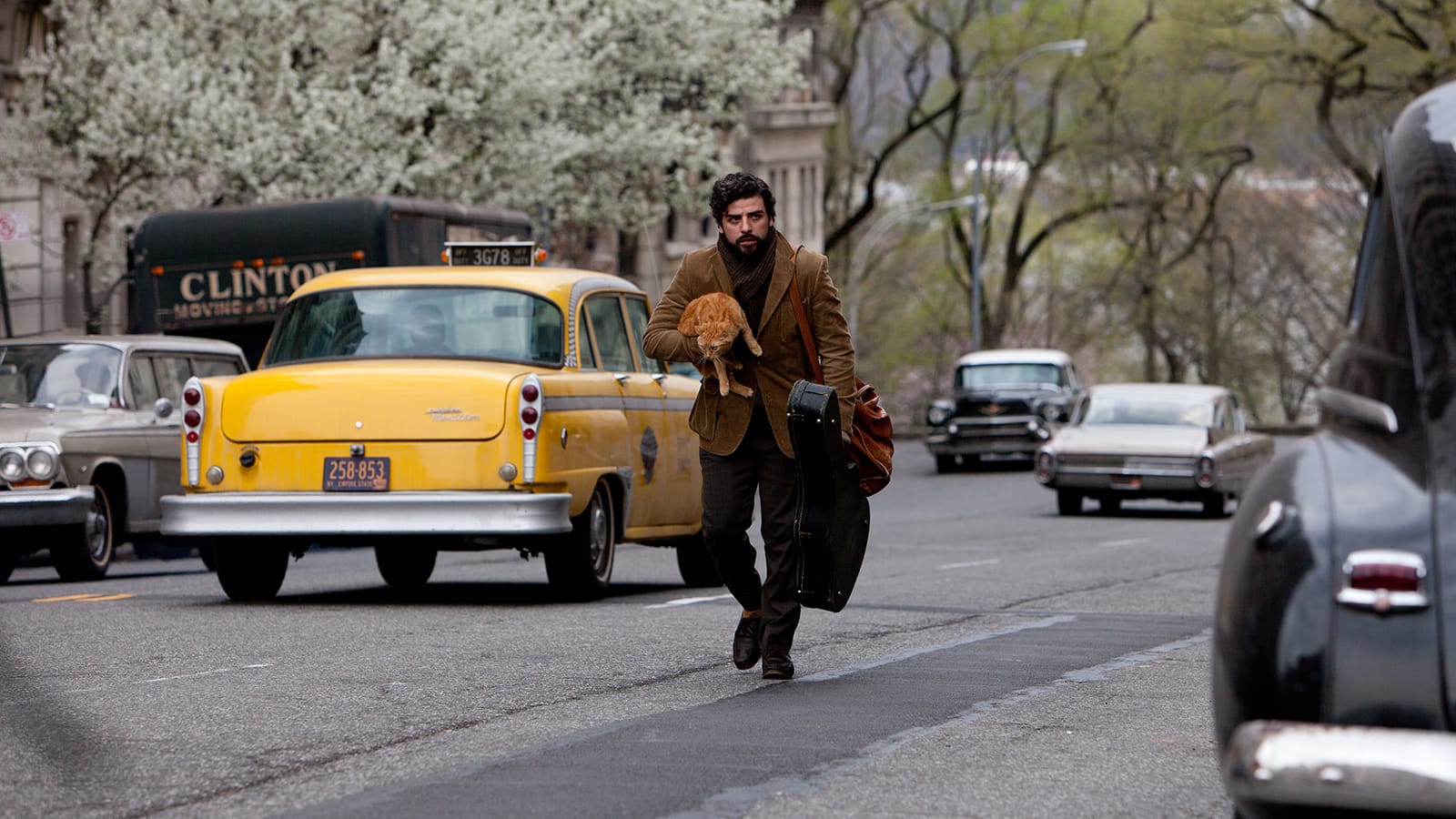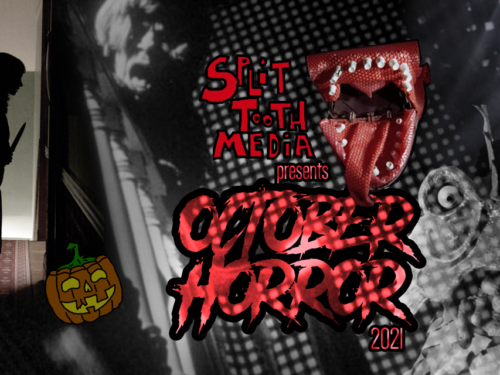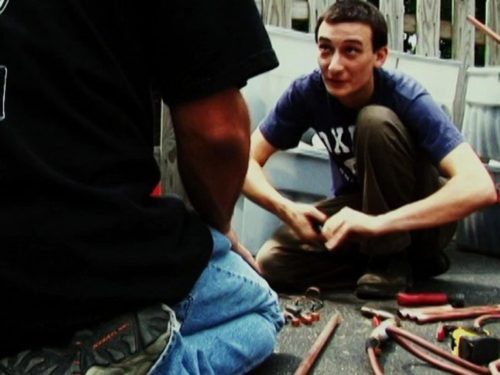The Coen Brothers’ historical fiction film of a struggling New York folk singer is one of the most successful integrations of music and film narrative in recent history
A cat doesn’t care about your plans. The titular struggling folk singer Llewyn Davis (Oscar Isaac) accidentally releases the cat of the Gorfeins, a well-to-do Upper West Side couple that lets him crash on their couch when he’s run through all his downtown friends. He’s reeling from the recent suicide of his singing partner, which has thrown him into an existential crisis. Llewyn spends the running time of the film trying to return the jail-breaked pet while hustling enough money to keep going as a musician. Llewyn wants a music career and the meaning and connection that he thinks would come with it. The cat is the perfect animal to say no. Maybe there’s comfort in the soft cat once I hold it? Nope, there it goes again. The cat takes off, shows up, escapes again, reveals itself to be a girl and not a boy (ergo not the Gorfeins’ cat), then watches stone-faced as Llewyn abandons her only to show up later in the street where Llewyn hits not-the-Gorfeins’ cat with a car. The pursuit of the real Gorfeins’ cat starts out embodying the Sisyphean toil of the artistic struggle, but when that injured cat, that not-the Gorfeins’ scrotum-less cat is slinking off into the wintry night, the hanging-by-a-thread folk singer Llewyn Davis sees himself in it. He’s in the wrong place at the wrong time. He’s the wrong cat. The Coen Brothers add their own philosophical bent to the artist on film. In a film about timeless music, the central singer is assaulted with bad timing, a knot of coincidence and serendipity all working decidedly against him, adding cosmic conspiracy to the repertoire of antagonists for the artist.
Llewyn Davis is an amalgam of also-ran 1960s Greenwich Village folk stars like Dave Van Ronk, talented people on the scene who were promptly forgotten after an unassuming Minnesotan named Bob Dylan showed up. The film follows Llewyn through a very bad week in the winter of 1961. The plot is a web of seemingly minor mistakes coming back around and undoing all of Llewyn’s plans. The unity and persistence of his failure seems to hold some kind of grand design he can never quite get at. Llewyn himself is full of contradictions. He’s talented and full of it; he’s hopeful and bitter; a showman and a curmudgeon; he’s self-aware, yet unable to change. What’s different about this film as opposed to the Coens’ long history of trapped, bumbling characters, is that this bumbler produces beautiful music. The Coens’ understanding of how to translate a style of song into a living, moving film, to make song and film play off and need each other, results in one of most successful integrations of music and film narrative in recent history.
Inside Llewyn Davis is the Coens’ most compassionate work. It navigates the problems of getting the artist and their art on film by borrowing freely from the biopic, documentary, and performance film modes. It makes its own mode, a historical fiction film. The songs in the film are all real folk songs that would show up in a sober documentary on the ’60s folk scene (with the exception of the film’s “selling out” novelty number that becomes a hit). Llewyn Davis is fictional, but most of the songs he sings were in the very real Van Ronk’s repertoire, as if it was his biopic. The film title itself is borrowed from Van Ronk’s album Inside Dave Van Ronk, and the Coens pick and choose from Van Ronk’s biography when it’s helpful to their design. The voice and guitar playing are not Van Ronk, but they are actor Oscar Isaac’s own. At the time of production, Isaac was a little-known actor, his casting a brave commercial risk to ensure the audience’s belief and investment in the music. The arrangements are all worked out by music producer and American folk music aficionado T-Bone Burnett, himself an expert at stripping away artifice and distraction from the truth of a song. The songs Llewyn sings are filmed uninterrupted, like little performance films woven into the fiction. Songs are presented simply with an emphasis on the environment in which they’re sung. Despite all these elements of the real, the film isn’t burdened like an artist doc or biopic with trying to grasp onto the breadth of a whole life. The film’s scope is narrow like a performance film — one week in 1961, getting the finely constructed part to stand in for the whole.
For the opening and closing number of the film, the Greenwich Village coffee shop is packed and reverent like a church. Llewyn sings under a spotlight, glowing in the smoky haze of the Gaslight’s beatnik basement ambience. The full room makes the stage feel open and elevated. The shadowed, silent crowd directs us to the delicacy of the music under the spotlit glow of the stage. Upon this alter, the Coens work with Burnett and Isaac to create real beauty, far from the ironic mode that they often operate in. Moreover, they understand that these performances are something else, they are not to be lavishly decorated with film style, fussed and mucked with; where Llewyn’s regular life is cramped and rushed, the Coens make space and time for these songs. Llewyn’s performances are these singular moments where everything goes right. The instant the number is over, everything goes wrong again, like after this opening song, when he’s called out to the alley and beaten up by a strange man, or when he reaches out to his aging merchant marine father at the rest home with a beautiful rendition of “The Shoals of Herring,” and Llewyn realizes that the communion he’s searching for is the look of his senile father soiling himself. The struggle of everything going wrong deepens the song, and the beauty of the song deepens the hurt of nothing working out.
Combining songs with film narrative is not an easy task. They are two different forms of communication. Folk songs, moreover, contain their own little narratives within, ready to buck up and clash with the larger picture. The Coens knit this problem together by constructing a character that resists our full understanding and song choices that offer a way in. The songs are desperately needed information. What is inside Llewyn Davis? Llewyn is closed and cantankerous, but his songs are open and aching. The songs don’t repeat what we’ve already seen. If anything, they are contradictory, throwing us back into the narrative for clues as Llewyn’s songs stand in contrast to his surly behavior.
The Coens understand that there must be growth and chemistry in the combination between song and narrative, as there is between melody and lyrics in song. Even the secondary musical characters in Inside Llewyn Davis contain compelling contradictions with their musical output so that we’re watching a continually evolving narrative instead of a meandering playlist. Llewyn’s ex-lover Jean (Carey Mulligan) sings angel sweet like Mary (of Peter and Paul) but is raging with anger off stage. Is the sweetness the reason Llewyn went for her or is it a sham and the reason he left? Jean’s new boyfriend, Jim (Justin Timberlake), soft-spoken and mild, invites Llewyn to sing on a bonkers novelty song called “Please Mr. Kennedy (Don’t Shoot Me into Outer Space).” The song becomes a huge hit and taunts Llewyn with the imbalance of quality versus commercial response. Troy (Stark Sands), a G.I. crashing at Jean’s appears to be an empty-headed yokel who taunts Llewyn with his aw-shucks lack of angst, but then he sings “The Last Thing on My Mind” with unexpected beauty. Llewyn balks incredulously. The coup de gras is when Llewyn, on his last legs, heckles the only authentic Arkansas folk singer at the Gaslight, calling her a phony, and asking if she wears gingham panties as she clings to her autoharp. No song in the film is ornamental. Each has a function in demonstrating the contradictions between song and singer that neither we or Llewyn can resolve. Every song that’s not Llewyn’s functions as an irritant to him, pointing to the maddening trap of comparing other artists’ reception to your own. What’s even more maddening is that from the perspective the film puts you in, Llewyn is right. His performances are more internal, his voice strains more with feeling, his phrasing less mannered. And because we are following his struggle, the songs deepen with the hurt of his failures.
A film about music needs to figure out how to deal with the non-musical elements so that the momentum of the film doesn’t come to a crashing halt when the number is over. Inside Llewyn Davis lays its narrative spine on Llewyn’s hustle to stay afloat: the demoralizing couch hopping, money borrowing, favor asking, barter system of commerce that the starving artist has to engage in to pay the rent. There is no score to the film. The sad stumble and toil of travel and movement is the music of the non-musical sections of the film; it drones, shifts, and lurches where the music flows and rolls. Llewyn is constantly on the move. The Coens film his subway trip to Greenwich Village through the train car window, as passing subway stops whip-whip-whip on by, turning a commute into a slow, punishing boxing match. When the Gorfeins’ cat leaps out of Llewyn’s lap on the subway, the camera takes us bobbing and darting along with Llewyn through the moving train in pursuit. Llewyn is always scrambling — a symphony of claustrophobic entrances and exits through all the desperate, dodging, double-backing drudgeries of being broke in a city. Putting us through the movements of Llewyn’s grind, we experience the sensation of struggle the songs are meant to liberate us from. The film grinds us into folk.
At midpoint, the film makes an unexpected shift in approach, as the hope for an audition with Bud Grossman (F. Murray Abraham, the character modeled after Dylan manager Albert Grossman) has Llewyn hitch onto a rideshare to Chicago. What was a coiled and anxious city rhythm becomes a slow, brooding country dirge. Not quite a liberation, the car contains the sour dozing jazz musician Roland Turner (John Goodman), taunting Llewyn from the backseat for his adherence to the primitive chord progressions of the folk form. Driving is Roland’s ‘valet’ Johnny 5 (Garrett Hedlund), a steely and frustrated poet/novelist. It’s a sarcophagus of artistic bitterness. Out of the car, Roland walks with arm crutches like the husband in Double Indemnity and suffers from a mysterious ailment that has him constantly nodding off. He heaves, sputters and collapses to the beat of Llewyn’s crumbling aspirations. There’s a moment where Llewyn witnesses Roland collapsed on a diner restroom floor, cheek to tile, foaming at the mouth. His assistant seems unphased and helps him up. From the tie-off around Roland’s arm, it appears a heroin addiction is the problem, but the image of Roland slapped out on the tile plays like a projection of Llewyn’s inner state. The slowed-down pace and the wide-open spaces of the trip are the cinematic equivalent to a musical bridge. The bridge is often, like here, a place where a song deepens before returning to its final punch. In this case, the Chicago trip clears the clutter for a deeper meditation of Llewyn’s future: the bleakness of the landscape and the sight of Roland’s decay predict rock bottom as standard procedure.
Somewhere outside Chicago, Llewyn ditches his ride with Roland, hitches another one, gets on a bus, gets kicked out of a bus station, is booted out of a diner, suffers a wet sock from a hidden puddle, and at last reaches the home of Bud Grossman: a theater called “The Great Horn” — the building name adding shades of the Odyssean to what is already an epic journey. Llewyn goes in and has to grovel for a chance to play. Grossman allows it. The theater is vast and empty, an apt setting for a final show-down with his dreams. He plays for Grossman alone. The Coens choose a song about sacrifice for life, “The Death of Queen Jane.” Llewyn sings like it’s the last chance he’ll ever have; he gives it his whole beleaguered soul. It’s a song about the Queen in the process of an agonizing nine-day labor to produce her child. She begs for the nursemaids, then the king himself to “open up my right side and remove my baby.” They refuse until it’s the only way forward and have to cut her open. The kingdom rejoices at the child while Queen Jane lies “cold as a stone.” The scene is cut using slow tracking shots moving in on Llewyn paired with the same toward Bud Grossman. As we go into Llewyn we know him more, as we go into Grossman, we know him less. It is art versus industry. Grossman speaks curtly after Llewyn finishes his soul bearing. “I don’t see any money in it.” Llewyn’s fortune slams down. Wherever the audience was at the beginning of the film, they have now experienced enough shared disappointment with Llewyn’s fortunes to feel the full parallel to the artist birthing a song only to be cruelly discarded and forgotten.
Llewyn returns to New York from his failure in Chicago and the Coens make a structural sleight of hand that further undercuts the chance of Llewyn ever escaping his predicament. The Arkansas folk singer Llewyn heckled turns out to have a husband that asks him to meet him out in the alley. He beats Llewyn up, a scene we suddenly realize we saw at the beginning. The whole film has been a cleverly concealed flashback. This, coupled with the immensity of the failed journey to Chicago, secures the irreversibility of failure. This structural revelation gives the audience the experience of someone thinking they’re moving forward, but realizing they’re on a hamster wheel going nowhere. Poor Llewyn doesn’t experience the flashback to have that revelation. He just stays on the wheel. Llewyn has been stripped down to a folk song, as locked into eternal struggle as Queen Jane.
As Llewyn leaves the club to walk into his beating, he sees a young Bob Dylan performing. The Coens elongate that moment with a gliding point of view and reaction shot of Dylan slipping into frame and Llewyn slipping out. It mirrors a POV and reaction shot couplet that happens on the highway back from Chicago. Llewyn recently learned he has a kid in Akron who he thought the girlfriend aborted. When he looks out at the window to the exit sign for Akron, the distant lights of the city glitter as he drives by. It’s shot just like his passing by Dylan, a walk past a glittery alternative life he could have had. Ultimately, he’s locked onto a highway, steered by his dysfunction and an inescapable fate. He can see the exits, but he can’t get off.
Inside Llewyn Davis sharpens the point found in the stories of artists ignored in their lifetime. Whether the audience hears what they are doing is not all about talent. This is a particularly difficult pill to swallow in American culture, which is meritocratic in aspiration, if not practice. The horror of the Coens’ artist film is that Llewyn is metaphysically stuck. Free will either doesn’t exist or won’t help. The mismatch of the cultural zeitgeist with Llewyn’s talent, combined with his particular emotional dysfunction will always lead Llewyn back to the same self-destructive place. As his ex-girlfriend Jean says, he has the reverse Midas touch: everything he touches turns to shit. The only tonic for that kind of situation is a major philosophical shift in how he sees the Universe, one we see no signs of Llewyn achieving. It’s always hard to see your own tragedy as comedy (I’m looking at you Van Gogh). That the Coens keep a bleak statement on the nature of free will from losing compassion for its subject is their great accomplishment. A more charitable hand of fate than the Coens’ waved posthumous fortune on Llewyn’s real life model Dave Van Ronk. Van Ronk got a Llewyn Davis bump. “Hang Me, Oh Hang Me” has 8 million listens on Spotify. Maybe he caught the Gorfeins’ cat after all.
Purchase Inside Llewyn Davis on DVD/Blu-ray from The Criterion Collection or Amazon
Stream Inside Llewyn Davis on Amazon Prime
Stay up to date with all things Split Tooth Media and stream Steve Collins latest film, I’ve Got issues.
(Split Tooth may earn a commission from purchases made through affiliate links on our site.)




